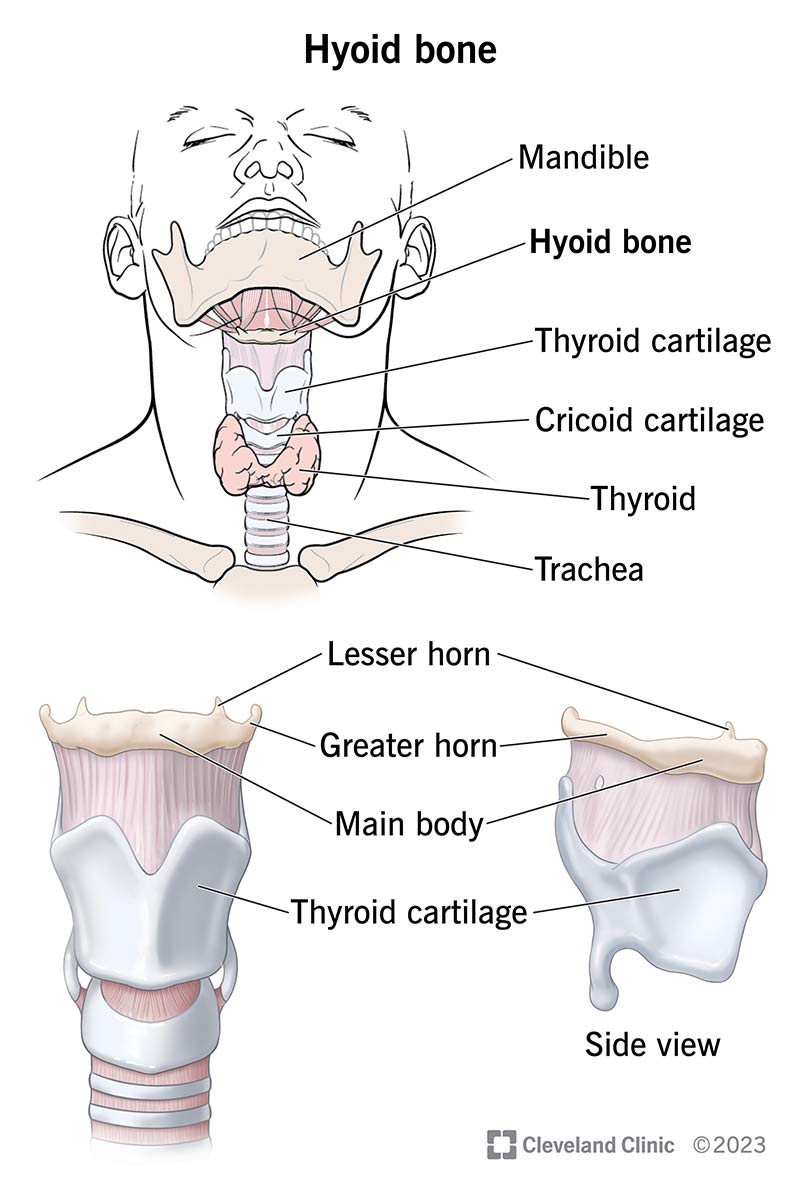Your hyoid bone is unique because it’s the only bone in your body that doesn’t connect to another bone. Instead, ligaments, muscles and cartilage keep this crescent-shaped bone in place, so it appears to be floating. Your hyoid bone helps you speak, swallow and breathe. Trauma is the most common reason for issues with your hyoid bone.
Advertisement
Cleveland Clinic is a non-profit academic medical center. Advertising on our site helps support our mission. We do not endorse non-Cleveland Clinic products or services. Policy

Your hyoid bone is a tiny bone at the front of your neck. It’s shaped like a crescent or the letter U. This bone sits below your lower jaw and above your thoracic cartilage, protective tissue that covers your vocal cords. You can feel your hyoid bone if you swallow while holding your fingers where your chin and neck meet.
Advertisement
Cleveland Clinic is a non-profit academic medical center. Advertising on our site helps support our mission. We do not endorse non-Cleveland Clinic products or services. Policy
Unlike most bones, your hyoid bone doesn’t have a direct connection to any other bone. Instead, ligaments, muscles and cartilage keep it in place, making it the only “floating bone” in your body.
It helps you to speak, swallow and breathe by supporting parts of your head and neck. Those include your:
Your hyoid bone sits at the front of your neck, below your lower jaw and above your thyroid cartilage. If you picture your spine, your hyoid bone “floats” in front of your fourth cervical (neck) vertebrae.
It’s easy to see on X-rays, ultrasounds or CT scans. Healthcare providers use these devices to look for issues with your hyoid bone.
There are three parts:
Advertisement
Your hyoid bone changes over time. You’re born with three separate bones. Between the ages of 40 and 60, the bones typically grow together to become a single U-shaped bone.
There are a few health conditions that can affect your hyoid bone, including:
Issues with your hyoid bone and your airway can lead to obstructive sleep apnea. Your throat muscles relax when you sleep. Your throat muscles attach to your hyoid bone. When the muscles relax, the bone and other muscles and ligaments that connect to it can fall backward into your airway and block it.
Conditions that affect your hyoid bone often have similar symptoms. Some of the most common ones include:
Some hyoid bone conditions cause symptoms that are like temporomandibular joint (TMJ) disorder symptoms. If you have TMJ that doesn’t get better with treatment, ask your healthcare provider to check your hyoid bone.
No, your Adam’s apple is a bump in the front of your throat. It’s made of cartilage.
Breaking your hyoid bone may affect your breathing if pieces of broken bone fall into your airway. Pain when you swallow and hoarseness are other things that may happen if you break this bone.
A surgeon could remove part of your hyoid bone without causing issues with the way you talk and swallow. They’d do this kind of surgery if you have a thyroglossal duct cyst.
Your hyoid bone is tiny but plays a big part in helping you speak, swallow and breathe. Fortunately, its location is tucked away under your lower jaw and protected from most types of harm. Hyoid bone conditions are rare. But talk to a healthcare provider if you have pain in your neck or throat that you can’t explain.
Advertisement
If you have conditions affecting your ears, nose and throat, you want experts you can trust. Cleveland Clinic’s otolaryngology specialists can help.

Last reviewed on 01/02/2026.
Learn more about the Health Library and our editorial process.